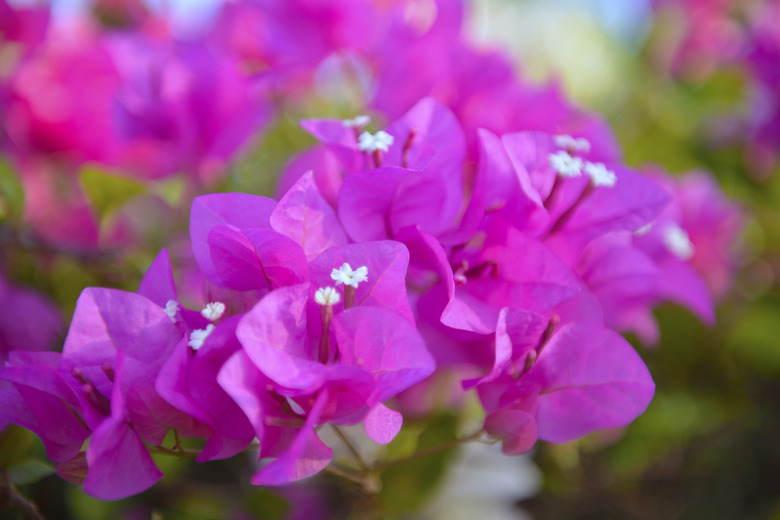How Does Bougainvillea Reproduce?
One of the reasons bougainvillea (Bougainvillea spp.) makes such a long-lasting, colorful display is that the bright structures thought of as "flowers" are papery bracts rather than true flowers. Each bract has a small, white, tubular flower at its base. The bracts remain fresh-looking after the flower withers, often for several months. Many varieties and hybrids exist, with plants hardy in U.S. Department of Agriculture plant hardiness zones 10 through 11, although they may survive winter damage in zone 9. Usually reproduced by rooting cuttings, bougainvilleas can also grow from seed.
Taking Stem Cuttings
Because you get an exact duplicate of the parent plant, rooting a cutting is a way to get the bougainvillea color and growth form you want. Time propagation during the summer, when branches are still growing at the tip but beginning to harden partway down the stem. First, clean a pruning shears with a cloth soaked in rubbing alcohol to prevent spreading disease. Then take a 6- to 8-inch-long tip cutting that's showing some bark formation at the base. Remove all but two or three leaves at the cutting's tip.
- One of the reasons bougainvillea (Bougainvillea spp.)
- The bracts remain fresh-looking after the flower withers, often for several months.
Rooting Stem Cuttings
To stimulate stem tissues to form roots, dip the bare end of the cutting into rooting hormone, making sure it contacts the cut end and the places leaves were torn away. Tap off any extra hormone powder. Then stick the cutting into a 2-inch pot that's been filled with a moistened rooting mix of half peat and half perlite. Place the cutting in bright indirect light within a plastic bag. Keep the rooting medium moist and wait for new leaves to form, indicating that the cutting has rooted.
Layering Stems
Another way to get a stem to root is to layer the stem while it's still on the plant. In spring, locate a stem close to the ground that's showing new growth. Bend it to the ground, wound the stem with a sharp, clean knife and coat the wound with rooting hormone. Bury the wounded area under the soil, holding it down with a piece of bent wire or with a rock. Wait until new roots form and then cut off the stem between the rooted area and the mother plant, transplanting the new cutting to its new garden location. Bougainvilleas are sensitive to root disturbance, so avoid damaging the roots.
- To stimulate stem tissues to form roots, dip the bare end of the cutting into rooting hormone, making sure it contacts the cut end and the places leaves were torn away.
Hybridizing Bougainvilleas
One of the ways to get new bougainvillea varieties is to hybridize existing species and varieties by cross-pollinating them to get seed. This recombines genetic material, taking one set of chromosomes from the pollen-bearing male parent and one set from the female parent, which bears the seeds.
Pollinating Bougainvillea
To transfer pollen, select a male parent that has a freshly opened flower and pick a flower. Split the floral tube open and locate the stalked stamens inside the flower, each with a pollen-bearing anther at its end. Collect some of the pollen on a cotton swab. After choosing a female parent, tear open the upper part of a flower to locate the female reproductive organ called the pistil, which has a blunt tip and is shorter than the stamens. Touch the tip with the pollen-coated swab. Mark the pollinated flower and wait for the 1/2-inch-long fruit to form at the flower base.
- One of the ways to get new bougainvillea varieties is to hybridize existing species and varieties by cross-pollinating them to get seed.
- After choosing a female parent, tear open the upper part of a flower to locate the female reproductive organ called the pistil, which has a blunt tip and is shorter than the stamens.
Growing From Seed
Once the bougainvillea fruit is dry and hard, collect the seeds. Fill a 4-inch pot with a soil-less mix containing perlite. Use a pot with drainage holes. Seeds don't need pretreatment, so scatter them evenly on the medium's surface. Cover the seeds with about 1/4 inch of the mix, tamp it down and water the pot until water comes through the drainage holes. Put the pot in bright indirect light and keep the soil moist. After the seeds germinate and have several sets of true leaves, transfer each to a 4-inch pot filled with the soil-less mix, disturbing the roots as little as possible during transplanting and watering seedlings well.
- Once the bougainvillea fruit is dry and hard, collect the seeds.
- Fill a 4-inch pot with a soil-less mix containing perlite.
